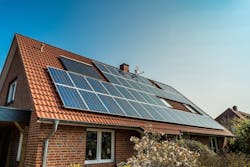Do Homeowners Really Use the Inflation Reduction Act?
According to the first report by the Treasury Department, 3.4 million households benefitted from the Inflation Reduction Act tax incentives for clean-energy home improvements last year. Those tax credits totaled $8.4 billion.
The Inflation Reduction Act (IRA) was introduced in August 2022 by President Biden. In the Act, existing tax credits—the Energy Efficient Home Improvement Credit and the Residential Clean Energy Credit—were expanded and extended. Homeowners who improved the performance of their homes through energy improvements, such as installing solar panels, heat pumps, insulation, and efficient windows and doors, could receive up to $1,200 annually with special credits up to $2,000, in addition to up to 30% off the cost of installing certain clean energy systems.
The number of households benefiting from tax incentives increased by one-third compared with 2021, according to the Treasury Department. As more returns are processed, the Department says they expect figures to increase.
According to an April 2024 poll conducted by AP-NORC, many Americans report not knowing enough about the IRA to say whether it’s had an impact.
Who Benefitted From Residential Energy Credits?
The Biden Administration said its incentives would help working families and small businesses save money on their monthly utility bills. The Treasury Department’s report found nearly half of the 3.4 million households—1.6 million—that benefitted from the IRA had incomes less than $100,000.
The household income range with the most returns at 35% were households with incomes between $100,000 and $200,000, totaling about 1.2 million households.
Which States Benefitted Most From The Inflation Reduction Act?
The states with the most tax returns that benefitted from an energy credit were California (397,970 households), Texas (316,600 households), Florida (306,470 households), and New York (189,680).
See the below chart for a full breakdown of state returns.
FIGURES FROM THE U.S. DEPARTMENT OF THE TREASURY
What Are the Most Popular Clean Energy Improvements?
Solar electric installations were the most popular home improvement at 752,300 households, followed by insulation or air-sealing material or system; exterior windows and skylights; and central air conditioners.
The least popular clean energy improvements were fuel cell (hydrogen), home energy audits, small wind energy, and biomass stoves and boilers.
How Much Did Households Receive in Credit?
On average for clean energy credits for costs of projects like rooftop solar panels, solar water heating, and home battery storage projects, households received $5,084 in credit.
For the energy efficient home improvement credit for projects like air sealing, windows, or heat pumps, households received an average of $882 in credit.
